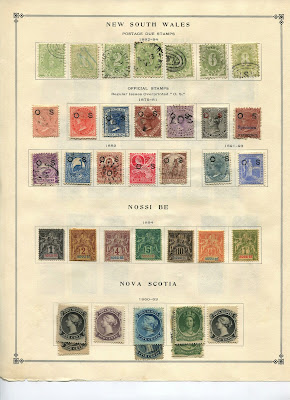Random thought 1: The “New” prefix on country names
(e.g., NSW, New Guinea, New Hebrides, etc.), occurs mostly in the South
Pacific. Explorers must have been homesick by the time they got there. After a
year or so at sea, any land must have reminded them of home; hence, “New”
something or other. BB albums have a clump of “New” country stamps from
countries that clump, well, mostly clump, together in the south seas.
Random thought 2: The British founded NSW in the late
18th Century as a penal colony. After the American Revolutionary
War, the British could no longer discard crooks in Georgia. So, they exported
them to NSW instead. Thieves had little
hope of returning home, ever. The flow of criminals continued until 1868. Some
of the early NSW stamps in our albums may have carried their letters to loved
ones back in England.
Random thought 3: NSW developed a system of coded
number cancels for post offices. The stamp with a “30” ray-type cancel (see
above, Scott #40) was pinked in Camden, a historic village now a suburb of
Sydney. Sydney had the largest concentration of prisoners, but Camden had some,
too. Ian Willis has written a history of the Camden crooks titled “Convicts in
the Cowpastures” (1).
Random thought 4: NSW stamps provide abundant
challenges for specialists -- perfs, watermarks, dies, color variations
galore. Scott lists a medley of 200; Gibbons has 400. Probably neither list has
exhausted the possibilities.
Random thought 5: NSW boasts an early embossed postal
envelope (1838) that precedes Britain’s penny black. Sadly, I don’t have one.
Random thought 6: The two postage due “specimens” on
the supplement page have different fonts for the overprints. I think they’re
genuine, but more research is needed. The Newcastle (another “new”) etiquette
probably was used after the Australian states unified. Newcastle, like its
British namesake, is a coal producing region. I wonder why they didn’t name it
New Newcastle.
Random thought 7: When designed or printed locally, British colonial stamps often have a quaint folkart quality about them. Scott #s 100 and 104 provide examples. The queen wears a scarf secured by a small diamond crown, a widow’s weeds accessory she often wore after Prince Albert’s death (1861).
Random thought 9: NSW issued two stamp designs with a
female personification of Australia (#108 shown above), a common practice in
the mid to late 19th century. I wonder, though, why Australia was
personified on a NSW stamp and not NSW itself. NSW did have a cartoon
personification, the “Little Boy from Manly”, but he never made it onto a
stamp. The little boy was later adopted by the newly unified Australia.
Random thought 10: NSW issued a two-stamp series in
1888 to celebrate its centennial -- considered to be the first commemorative
stamps. I have only one of them.
Census: 52 in BB spaces, 2 tip-ins, 21 on supplement
page.
(1)
https://camdenhistorynotes.com/2017/03/04/convicts-in-the-cowpastures-an-untold-story
What Australians have in common, though, is their love of sports. I became introduced to "Australian Rules Football" while staying with an Australian family, with whom we had become friends, when they lived in the U.S.. They were supporters of the Sydney Swans- even though they lived in Melbourne. It turns out that the Sydney Swans moved from Melbourne many years ago, but loyalty is forever. ;-)














No comments:
Post a Comment